Tail lamps
The post The Railway at Night mentions the use of a red tail lamp as a 'last line of defence' in preventing collisions and that technique remains in use on today's railways.
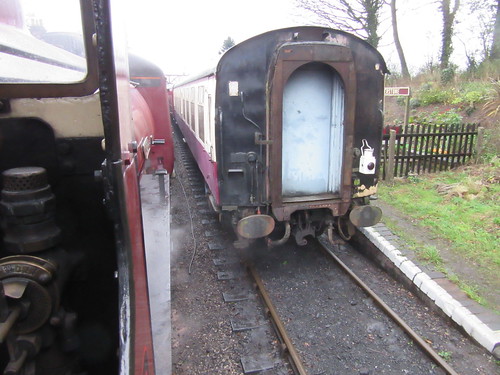 British Railways coach with two tail lamp brackets mounted on the corridor connection (either could be used), high up on the left, lower on the right, with a lamp. On other designs, the brackets may be mounted on the end wall of the coach.
British Railways coach with two tail lamp brackets mounted on the corridor connection (either could be used), high up on the left, lower on the right, with a lamp. On other designs, the brackets may be mounted on the end wall of the coach.
Goods trains presented an increased hazard. They tended to be slower and could readily become stalled on gradients or stop at stations to attach or detach wagons. They generally were 'loose coupled', without continuous brakes so the only brake effort was on the locomotive, supplemented by a handbrake in the Guard's Brake Van which was the last vehicle in the train. To mitigate these risks, in addition to a tail lamp, side lights were carried (as described in MIC - Lamps).

LMS 20-ton brake van No. 747 at Peak Rail. This vehicle has two tail lamp brackets on the end wall (either could be used) and side lamp brackets mounted high up on each corner post.
When locomotives carried a tail lamp (running light engine or 'banking') it was commonly carried above either rear buffer.
Sometimes additional tail lamps were carried which usually indicated that an additional train was following or that the train included one or more 'Slip Coach' to be detached on the journey without stopping the main train.
Head lamps
As the railway system became more complex, the need for signalmen and others to correctly identify an approaching train, so that it could be dealt with appropriately, became important.
Headcode indicating class of train
Different headcodes indicated the type of train, for instance express, stopping passenger, through freight, pick-up freight. On many British Railways, the use of four lamp positions on the front of locomotives was adopted: one adjacent to the chimney, one above each front buffer and one in the centre of the buffer beam. These positions were usually replicated at the rear for when the locomotive was working tender- or bunker-first. In most cases, different combinations of up to three lamps would give sufficient indication of the type of train. The appropriate code was carried by day and by night and at night or in conditions of poor visibility (fog or falling snow) the lamps were to be lit.
Different railways used locomotive lamps of various patterns. For instance, the London & North Western Railway (LNWR) originally used lamps which 'plugged' into a substantial cast socket. That design gave way to the simpler flat bar type of 'lamp iron' (although lamps for other purposes on the LNWR, like Gate Lamps, continued to use the cast socket approach which gave accurate alignment). Most railways used lamp irons with the broad flat facing forward but the Great Western fitted them with the broad flat facing sideways, requiring a different pattern of lamp (see MIC - Lamps). I remember in the late 1950s, when ex-LMS '8F' locomotives were transferred to ex-GWR Stourbridge shed, the lamp irons had to be changed to match the lamps in use at the shed! [this is mentioned in note (13) of article Traffic Movements at Sedgeley Junction 1962-1963 (Part 16)]].
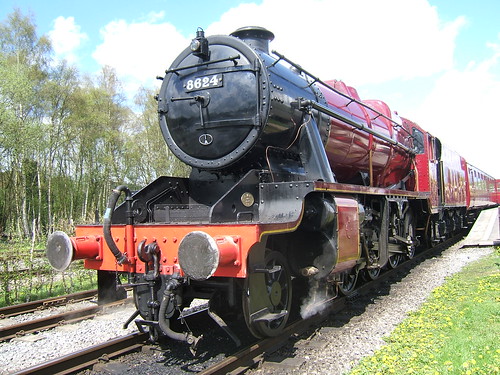
8624, a preserved Stanier '8F' (in the wrong livery) at Rowsley, with four LMS-pattern lamp irons, carrying one LMS-pattern oil lamp (painted black) in front of the chimney ('Ordinary Passenger Train').
Although there were (until Nationalisation) many independent railways, the need to apportion passenger and freight receipts fairly on journeys between different railways gave rise to the creation of the Railway Clearing House (RCH) in 1842 which was modelled on the existing Bankers' Clearing House system. This led to a limited amount of co-operation on non-commercial matters and one result was that a number of railways used the same headcodes. Exceptions abounded, particularly on lines jointly owned by two or more companies. Some lines used discs, rather than lamps, by day.
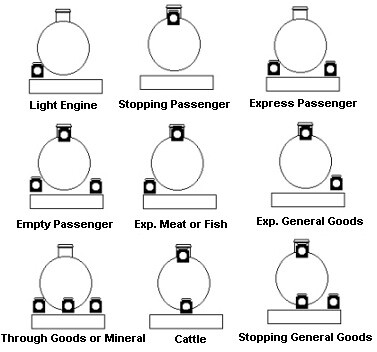
Early RCH Headcodes (from the useful Goods & Not So Goods site).
Some of the above RCH headcodes required three lamps so, following the Railways Act of 1921 which combined the railways into four Groups, a simplified set of headcodes was agreed. Each class of train was associated with a letter so an express became a 'Class A'.
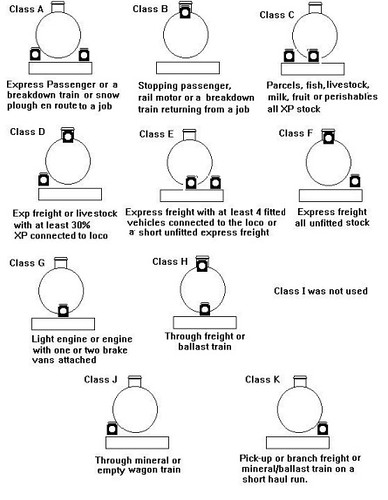
Later RCH Headcodes (from the useful Goods & Not So Goods site).
Headcode indicating route of train
On complex (particularly suburban) networks, the indication of 'Class' of a train gave insufficient guidance to signalmen and so headcodes were used to indicate the 'Route' of the train. This could involve additional positions for lamps - the Great Eastern Railway (GER) and London Brighton & South Coast Railway (LBSCR) used six positions. The Caledonian Railway supplemented the lamp indications with a small Semaphore route indicator carried in front of the chimney [see O.S. Nock's 'The Caledonian Railway' (Ian Allan 1961) pp 184-185]. Forms of route indication by disc or lamp survived until the end of steam on British Rail. By this time, the use of '4-character headcodes' had been introduced which I hope to cover in another article.
Use of Electricity
All the lamps discussed so far have been oil lamps but Britain made some use of electricity. British Railways introduced the battery-operated flashing red tail lamp ('flasher') still in use. Some steam locomotives were provided with electric head- and tail-lamps, as described in the post Electrical Systems on Steam Locomotives.

'Mayflower' being prepared for service at Shackerstone, showing the electric headlamps fitted to this locomotive, plus an LNER-pattern oil lamp (painted white) in the 'Light Engine' position.
A Historical Curiosity
In Richard Blythe's 1951 book ‘Danger Ahead’, I found a copy of an 'announcement', in 1845, by Thomas Forsyth regarding his patented system of white lights to be carried on locomotives to identify the type of train, together with a system of light (rather than semaphore) fixed signals. I don't believe his ideas met with great commercial success, but he was clearly thinking in the right direction. The 'light signal' in the picture looks remarkably modern but I don't know how Forsyth intended to achieve the 'searchlight effect' depicted by the artist with the available technology.
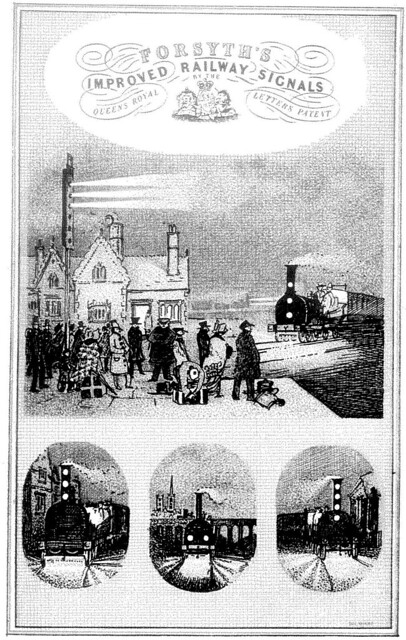
1845 advertisement for Thomas Forsyth's patented system.
Related articles on this web site
The Railway at Night.
MIC - Lamps.
Electrical Systems on Steam Locomotives
Recommended articles on other web sites
Train reporting number (Wikipedia).
Bell Codes & Locomotive Head Codes (The 'goods and no so goods' site).
TRAIN HEADCODES AND BELL SIGNALS (Western Region & GWR).
GWR headcodes (The extensive 'WarwickshireRailways.com site).
GER headcodes part 1 (The large Great Eastern Railway Society site).
GER headcodes part 2 (The large Great Eastern Railway Society site).
Steam Era Headcodes (The amazing Southern E-Group site).
